Sustainable Facilities
Greening the Built Environment

The buildings in which we live and work have environmental impacts. Mindful planning and design of these buildings can lead to a healthier, more productive workforce. As an occupant, you can take energy conservation measures such as turning off unused lights and opting to take the stairs in order to reduce the environmental impact of your building.
Environmental Impacts of Buildings
According to the U.S. Department of Energy, buildings account for over 40% of primary energy consumed in the United States. Operating buildings efficiently and designing new buildings with resource consumption in mind can help reduce buildings’ burden on the environment.
By installing energy-efficient and environmentally preferable features such as LED lighting, low-flow toilets, and automatic-shut-off HVAC systems, a sustainable facility can better use resources and minimize its footprint, reducing energy use and, consequently, our dependence on the potentially health-damaging process of burning fossil fuels
Examples of Green Building Features
- Exterior sun shades to reduce glare and reduce use of lighting, heating, and cooling systems
- Automatic systems for powering down lights and other energy-consuming utilities during off hours
- Conservation fixtures and technologies such as low-flow toilets and LED lighting systems
- Rich, interesting environments that encourage occupants to be active and more productive
- Attractive stairwells located in more prominent locations than elevators to encourage stair use, which builds muscle strength, increases stamina, and burns calories
- Exercise facilities and active-commute amenities such as showers, lockers, and bike parking to encourage physical activity throughout the workday
- Operating buildings efficiently and designing them with resource consumption in mind to help reduce their environmental burden.
Tips for the Home and Office
- Turn off the lights when not in use
- Consider using task lighting and turning on fewer lights
- Fix leaky faucets and toilets, or contact your facilities management office
- Adjust temperatures to be warmer in warm months and cooler in cool months
Related Links
- Page last reviewed: April 3, 2012
- Page last updated: April 3, 2012
- Content source:


 ShareCompartir
ShareCompartir